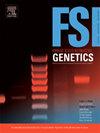Investigating SNP typing using alternative reference materials with the FORCE panel and QIAseq® chemistry
IF 3.1
2区 医学
Q2 GENETICS & HEREDITY
引用次数: 0
Abstract
Advancements in forensic science have introduced single nucleotide polymorphism (SNP) markers as crucial tools in kinship, ancestry, and identity testing, and in predicting phenotypic traits. The emergence of Forensic Genetic Genealogy (FGG) and massively parallel sequencing (MPS) technologies have further enhanced the utility of SNP markers, generating interest in their application within the forensic community. The FORensic Capture Enrichment (FORCE) panel, targeting 5497 SNPs including those associated with ancestry, phenotype, identity, and kinship, is specifically designed for direct kinship comparisons and the recovery of autosomal markers for direct identification in cases where traditional short tandem repeat (STR) typing is unsuitable.
This study aimed to evaluate alternative reference materials—hair roots, hair shafts, and fingernail clippings—using the FORCE panel and QIAseq® chemistry for direct identification. We assessed SNP recovery and concordance between these materials and buccal swabs, and we compared predictions for phenotype, Y-haplogroup, and biogeographic ancestry. Additionally, the study examined the concordance and performance on two sequencing platforms: MiSeq FGx and NextSeq 550.
Our results demonstrated high (99.62–100 %) SNP concordance rates between alternative reference materials and buccal swabs, with fingernail samples showing the highest SNP recovery and concordance of the alternate reference materials. Phenotypic, ancestry, and Y-haplogroup ancestry predictions from alternative materials were 100 % consistent with those from buccal samples. However, some discrepancies in phenotype predictions were noted when comparing predictions to self-reported data. Both sequencing platforms provided comparable results, with NextSeq 550 mid-output kit offering 3.5X higher coverage and potential cost-saving advantages through greater sample multiplexing.
In conclusion, the FORCE panel, combined with QIAseq® chemistry, effectively profiles SNPs from various alternative reference materials, offering reliable concordance and comprehensive genotype recovery even from low-input and degraded samples. This highlights its potential application in forensic investigations where traditional reference samples are unavailable.
使用FORCE面板和QIAseq®化学替代参考物质研究SNP分型
法医科学的进步已经引入了单核苷酸多态性(SNP)标记作为亲属关系、祖先和身份检测以及预测表型性状的重要工具。法医遗传谱系(FGG)和大规模平行测序(MPS)技术的出现进一步增强了SNP标记的实用性,引起了他们在法医界应用的兴趣。法医捕获富集(FORCE)面板,针对5497 snp,包括与祖先、表型、身份和亲属关系相关的snp,专门设计用于直接亲属比较和在传统短串联重复(STR)分型不适合的情况下恢复常染色体标记进行直接鉴定。本研究旨在使用FORCE面板和QIAseq®化学直接鉴定评估替代参考材料-发根,发干和指甲剪。我们评估了这些材料与口腔拭子之间的SNP恢复和一致性,并比较了表型、y单倍群和生物地理祖先的预测。此外,该研究还检测了两个测序平台(MiSeq FGx和NextSeq 550)的一致性和性能。我们的研究结果表明,替代标准材料与口腔拭子之间的SNP一致性率很高(99.62-100 %),其中指甲样本的SNP回收率和一致性最高。表型、祖先和y -单倍群祖先的预测与口腔样本的预测100% %一致。然而,当将预测与自我报告的数据进行比较时,注意到表型预测中的一些差异。两种测序平台都提供了可比较的结果,NextSeq 550中输出试剂盒通过更大的样品复用提供3.5倍的覆盖范围和潜在的成本节约优势。总之,FORCE面板结合QIAseq®化学,有效地分析了来自各种替代参考物质的snp,即使从低输入和降解的样品中也能提供可靠的一致性和全面的基因型恢复。这突出了它在无法获得传统参考样本的法医调查中的潜在应用。
本文章由计算机程序翻译,如有差异,请以英文原文为准。
求助全文
约1分钟内获得全文
求助全文
来源期刊
CiteScore
7.50
自引率
32.30%
发文量
132
审稿时长
11.3 weeks
期刊介绍:
Forensic Science International: Genetics is the premier journal in the field of Forensic Genetics. This branch of Forensic Science can be defined as the application of genetics to human and non-human material (in the sense of a science with the purpose of studying inherited characteristics for the analysis of inter- and intra-specific variations in populations) for the resolution of legal conflicts.
The scope of the journal includes:
Forensic applications of human polymorphism.
Testing of paternity and other family relationships, immigration cases, typing of biological stains and tissues from criminal casework, identification of human remains by DNA testing methodologies.
Description of human polymorphisms of forensic interest, with special interest in DNA polymorphisms.
Autosomal DNA polymorphisms, mini- and microsatellites (or short tandem repeats, STRs), single nucleotide polymorphisms (SNPs), X and Y chromosome polymorphisms, mtDNA polymorphisms, and any other type of DNA variation with potential forensic applications.
Non-human DNA polymorphisms for crime scene investigation.
Population genetics of human polymorphisms of forensic interest.
Population data, especially from DNA polymorphisms of interest for the solution of forensic problems.
DNA typing methodologies and strategies.
Biostatistical methods in forensic genetics.
Evaluation of DNA evidence in forensic problems (such as paternity or immigration cases, criminal casework, identification), classical and new statistical approaches.
Standards in forensic genetics.
Recommendations of regulatory bodies concerning methods, markers, interpretation or strategies or proposals for procedural or technical standards.
Quality control.
Quality control and quality assurance strategies, proficiency testing for DNA typing methodologies.
Criminal DNA databases.
Technical, legal and statistical issues.
General ethical and legal issues related to forensic genetics.

 求助内容:
求助内容: 应助结果提醒方式:
应助结果提醒方式:


